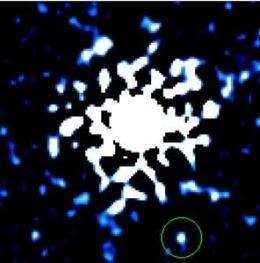Imaging the planet-sized companion of a nearby star

(PhysOrg.com) -- Of the nearly 500 extra-solar planets that have been confirmed to date, only about a dozen have actually been seen in images. Because planets are so much fainter than their host stars, special techniques are needed to obtain such images, and even these work only when circumstances are optimum, for example, when the stellar system is viewed face-on and the planet is far enough away from the star.
Nearly all planetary detections use more common methods that monitor stellar wobble or stellar brightness variations (due to transiting or lensing). Besides being visually dramatic, direct imaging has the advantage of readily determining a planet's distance from the star, and sampling its light directly. If the planet is a giant (as large or larger than Jupiter), then it may have an internal heat source as well as a reflecting atmosphere, in which case it can stand out more distinctly from its stellar host at infrared wavelengths. Astronomers trying to improve the statistics of imaged planets are on the lookout for nearby stellar systems which might permit discovery or the direct detection of an extrasolar planet.
The MMT Observatory has a relatively new infrared camera, called Clio, that can take advantage of the superb angular resolution possible there. Daniel Fabrycky and Ruth Murray-Clay, along with four colleagues, used Clio to image the nearby star GJ 758 (located only about 50 light-years away from earth) and its previously detected companion. Their infrared images not only showed the planet, but allowed them to measure its flux well enough to estimate its temperature and mass, the latter depending on its age and on models of planet evolution.
The scientists report that the object orbiting GJ 758 has an atmospheric temperature of about 290 degrees Centigrade or about 560 kelvin. If the planet is as young as about one billion years, it has a mass of between 10 and 20 Jupiter-masses; if it is as old as 8.7 billion years, then its mass is more likely twice as large. In either case the mass result is a particularly important conclusion for three reasons. First, the companion might not be a "planet" at all. It appears large enough to be a small star, a so-called "brown dwarf" - not big enough to burn hydrogen (as occurs in a star's nuclear furnace), but able to burn deuterium (deuterium, a hydrogen-like atom with one neutron in its nucleus along with one proton, fuses into helium at lower temperatures than does hydrogen). If the companion is a brown-dwarf, then it would be an exception to the postulated "brown-dwarf desert" theory in which stellar companions can be planets or other stars but (for unknown reasons) not easily brown dwarfs.
The other two important conclusions are equally provocative. In the context of this stellar system, its large size seems to exclude (or at least make less likely) those theories of planet/companion formation in which mass is steadily accreted by the growing planet, the alternative being that it grows as the result of sticking collisions between smaller bodies. Moreover, if the companion really is a small star, then GJ 758 is actually a binary star and not a planetary system - and one of the smallest known binaries at that.
Provided by Harvard-Smithsonian Center for Astrophysics



















